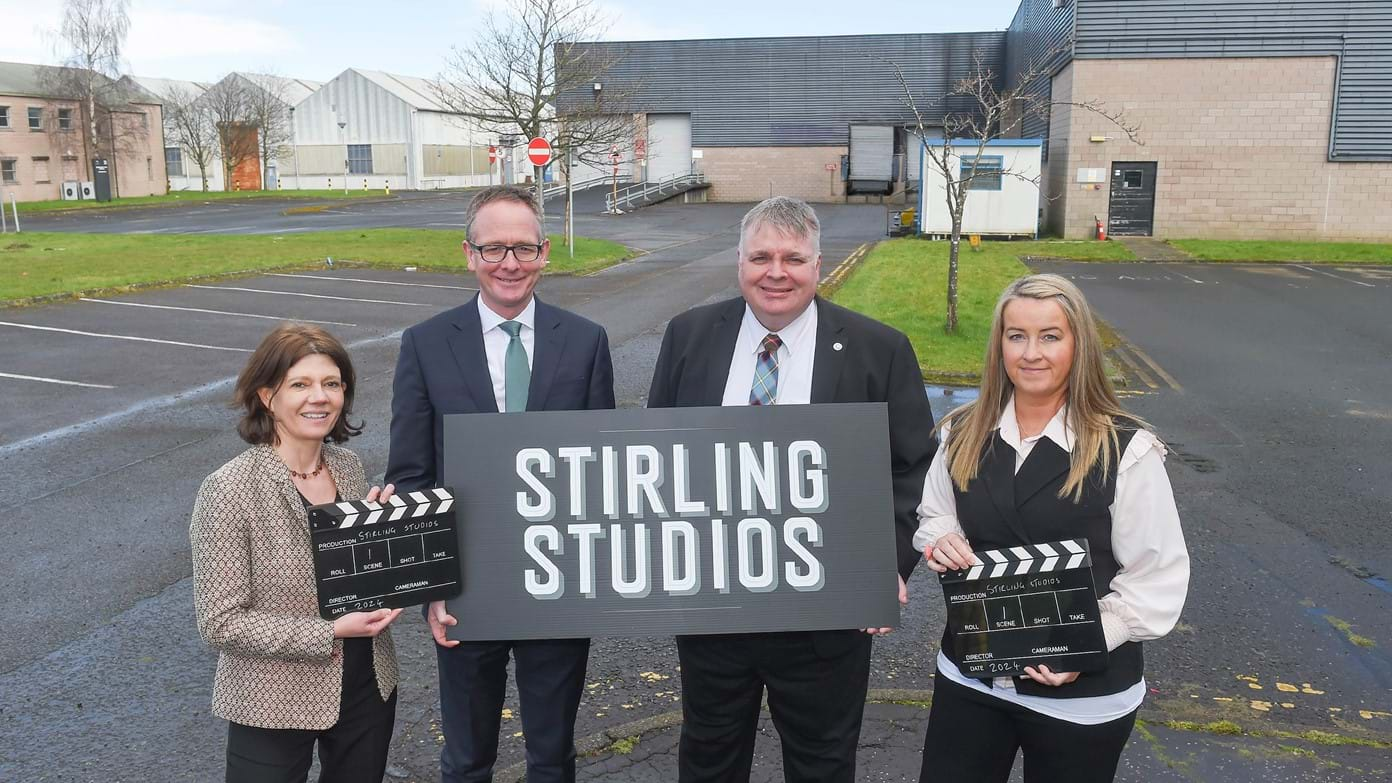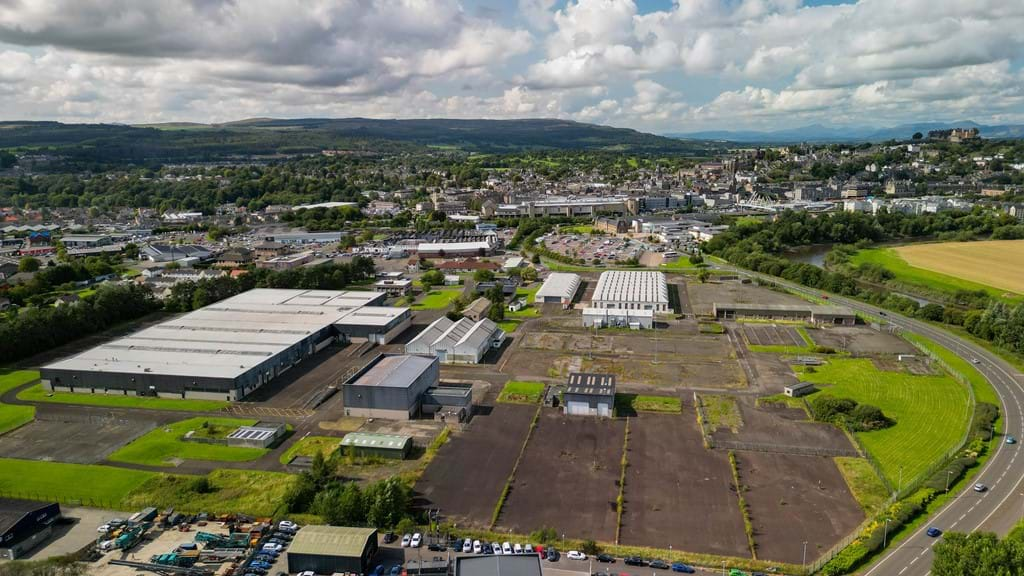Stirling unveils studios plan for former MoD land

Isabel Davis, executive director Screen Scotland; UK Government minister for Scotland John Lamont; Stirling Council leader Cllr Chris Kane; Stirling Council chief executive Carol Beattie
Stirling Council has unveiled plans to deliver one of the biggest film studio campuses in Scotland.
Seto to be located on the former MoD land at Forthside, Stirling Studios will pave the way for thousands of high-skilled jobs as well as major economic benefits.
Stirling Council chief executive Carol Beattie is confident about the future success of the studios as she identified that the site and buildings could fit well with the needs in the sector.
She said: “In a previous role as director of Creative Industries for Scottish Development International, I knew there was still an opening for more production space in Scotland. At that point, I spent time in London speaking to the British Film Commission and studio operators such as Pinewood, Three Mills and Warner Brothers to understand the specifications of a good site.
“When I saw the unique buildings and location at Forthside, I considered it to be a fantastic fit, which has since been confirmed through our close consultation with the industry, including Screen Scotland.”
Screen production is continuing to experience rapid growth driven by consumer demand for content across multiple distribution platforms such as Netflix and Amazon. Worldwide, in 2019, screen sector production had a total economic impact of $414 billion and supported 14 million full time jobs.
Market trends, together with the hugely successful UK tax credits system, have driven a sustained expansion in TV and film productions across the UK. In 2021, total spend in the UK was £5.64bn, up from £3.12bn in 2021. This has been mirrored in Scotland with a recent Screen Scotland report showing a doubling of film and high-end TV production in the country between 2019 and 2021.
Stirling Studios will unlock significant investment and job opportunities, as well as an array of economic and social benefits. An independent economic impact assessment has estimated the project will create over 4,000 jobs in 25 years in a range of occupations, with the positive impacts filtering down the wider supply chains.
Whilst some of the job creation opportunities for film and TV production roles may immediately suggest acting, directing or producing, the range of jobs across existing industries within the Stirling and Forth Valley area that are required within the sector should not be underestimated.
Accessibility to a skilled workforce of joiners, labourers, plasters, scaffolders, lighting and electrical engineers, costume design, hairdressers, make-up artists etc. are critical in this sector and Stirling’s historical strengths in these areas provides a unique opportunity for growth.
Stirling’s geographical location provides the perfect triangle of success for the sector, with easy access for the talent from Glasgow, where crew base is well established, from

An aerial view of the former MoD land where Stirling Studios will be located
The studios will be located on the former MoD land at Forthside which has been transferred to the council through the Stirling and Clackmannanshire City Region Deal – a £214 million partnership between Stirling and Clackmannanshire councils, the University of Stirling and the UK and Scottish Governments.
This ambitious project has been supported by repurposing a proportion of the £19m grant secured by the council from UK Government’s Levelling Up Fund (LUF) for the redevelopment and regeneration of Forthside.
Stirling Council leader, Cllr Chris Kane, said: “Stirling Studios brings one of those rare moments in Stirling’s history which offers the potential to be truly transformational.
“We have an opportunity to embed an industry in our city which will bring thousands of high-skilled jobs, put us on a global creative map and deliver a significant economic boost to the region over many decades.
“By making innovative use of the existing buildings on a former military site, we are creating a studio campus that will provide everything film producers need to meet demand in a thriving sector.
“Students in our schools, our college and our University will be able to pursue creative careers right here in Stirling that in the past would have meant having to consider leaving to chase opportunities elsewhere.
“I would like to thank everyone involved for their hard work in getting us to this point. We are determined to seize the moment for the people of Stirling and realise the rewards of this ambitious project.”
Rather than demolishing and clearing all of the existing buildings on the MoD land as previously intended, some of these will be retained and refurbished for the film and high-end TV campus. This will accelerate the start of economic activity and job creation on the site as early as this year, with the council currently investigating the best option for operating the facility.
The remainder of the land will be redeveloped and cleared in line within existing plans, including the buildings not suitable for reuse. The other projects identified in the LUF bid, such as new roads, will still be delivered by early 2026 as a new sustainable and economically vibrant community takes shape in the Forthside area.
Experts have assessed there is currently 100,000 sq ft of studio space and 110,000 sq ft for production, logistics and office space at the site. This significant capacity and flexibility of space will enable Stirling Studios to fill current gaps in the market for TV and film production and support the rapid growth of the sector in Scotland and the UK.
Feedback on Stirling Studios from operators, producers and directors has been overwhelmingly positive, not only about the facilities but the other advantages of the site. These include: Stirling’s stunning scenery and natural landscapes, its central location, excellent transport links, as well as the opportunities to increase Scotland’s talent pool in a thriving sector through partnership working with the likes of the University of Stirling and Forth Valley College.
The site has already been used as a filming location which will provide valuable experiences and lessons to serve future high-end productions.





















